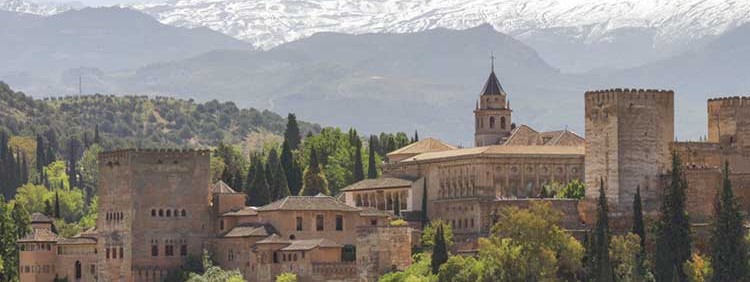Spain’s Moorish swansong
“Give him alms, woman, for there is nothing like the grief of being blind in Granada”, so says the city’s motto, from the verse of Francisco de Icaza. Despite being rather over-the-top and melodramatic, to say that Granada is a delight to the eyes is no idle boast. Built on hills which afford stunning views to snow-capped mountains and across broad plains, there can be few cities so well favoured by their natural surroundings. It is not hard to understand its appeal to the successive peoples who have given Granada its rich history, from the Romans through to the Catholic Monarchs, conquerors of the city from the Moors in the late 15th century. Each has left its mark upon the city in countless ways, but Granada is known above all for its Moorish heritage, a dominion of seven centuries which lasted longest here, and which is epitomised by the dream-like Alhambra palaces.
This complex of fortresses, palaces and gardens, built largely in the 13th and 14th centuries by the Nasrid sultans, is the focus of everyone’s gaze when they visit Granada and rightly so. It is hard to envisage a more beautiful setting, on the wood-covered Sabika hill, seemingly floating between the city and the Sierra Nevada. Your first sight of one of the world’s most beautiful monuments is likely to remain long in the memory, but the Alhambra also rewards with new pleasures on every reacquaintance. The intricate plasterwork engravings from the Koran in the sumptuous courtyards, the play of water in the pools of the Generalife gardens, the views across to the Albaicín (Moorish quarter) from the ramparts of the Alcazaba fortress – all can be appreciated in so many different ways.
Although the Alhambra has naturally come to personify Granada, the city has many fascinations and charms beyond its walls. The historic districts of the Albaicín, Realejo and Sacromonte, each with a distinct character, hold a wealth of interest. The Albaicín is one of the finest examples in Europe of a medieval town, being still based on the layout of the Moors – all crooked, cobbled streets and tightly packed houses. The Realejo is perhaps the best place to see contemporary granadino life, in what is still a very traditional neighbourhood. Sacromonte is a beguiling eccentricity: full of folklore and legends. Formerly home to a sizeable gypsy population, it still attracts visitors to night-time flamenco performances in its cave houses but also those who appreciate its semi-rural tranquility and the fabulous views back to the Alhambra and the city.
The historic heart of Granada is the square of Bib-Rambla, the pavement cafés and souvenir stalls of today telling little of a tumultuous past of mass burnings of Arab books, Inquisition trials, joustings and bull fights. The Cathedral and Royal Chapel are nearby, one a vast Renaissance structure with an imposing main Baroque façade, the other delicate, on a far more human scale. The chapel houses the mortal remains of Christian Spain’s great immortals: Ferdinand of Aragón and Isabella of Castilla, the “Catholic Monarchs”.
The Moorish stamp is still visible not just in the Albaicín but also in the centre, where the Grand Mosque, the Madraza (university) and the Alcaicería (market for silks, jewelry, spices) were once the focal point of the city. The Mosque was destroyed to make way for the Cathedral but the last two still stand – although only the beautiful oratory of the Madraza remains and the alleyways of the Alcaicería are a replica of the original market which was destroyed by fire in 1843. A further flavour of the past is provided by two streets known colloquially as “las teterías” (“the Arab tea shop streets”) where North African traders sell furniture, clothes, teas, spices, lamps, rugs and the like.
Various of our Sample Itineraries feature the city, be it for Culture or Gourmet, and the surrounding countryside offers many Outdoors options too. In the words of The Rough Guide “If you only see one city in Spain, it should be Granada”.
